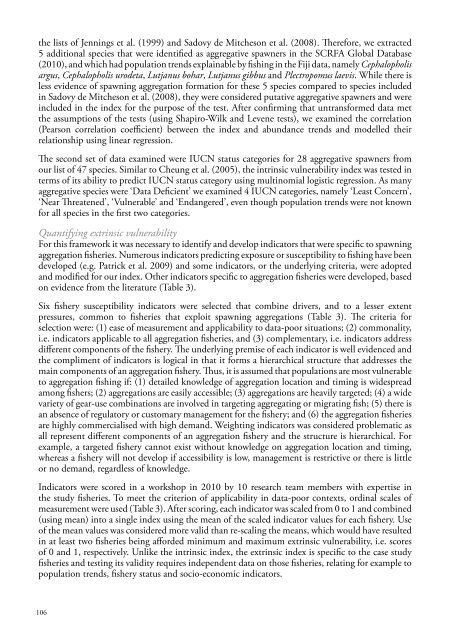WIOMSA-CORDIO spawning book Full Doc 10 oct 13.pdf
WIOMSA-CORDIO spawning book Full Doc 10 oct 13.pdf
WIOMSA-CORDIO spawning book Full Doc 10 oct 13.pdf
You also want an ePaper? Increase the reach of your titles
YUMPU automatically turns print PDFs into web optimized ePapers that Google loves.
the lists of Jennings et al. (1999) and Sadovy de Mitcheson et al. (2008). Therefore, we extracted5 additional species that were identified as aggregative spawners in the SCRFA Global Database(20<strong>10</strong>), and which had population trends explainable by fishing in the Fiji data, namely Cephalopholisargus, Cephalopholis urodeta, Lutjanus bohar, Lutjanus gibbus and Plectropomus laevis. While there isless evidence of <strong>spawning</strong> aggregation formation for these 5 species compared to species includedin Sadovy de Mitcheson et al. (2008), they were considered putative aggregative spawners and wereincluded in the index for the purpose of the test. After confirming that untransformed data metthe assumptions of the tests (using Shapiro-Wilk and Levene tests), we examined the correlation(Pearson correlation coefficient) between the index and abundance trends and modelled theirrelationship using linear regression.The second set of data examined were IUCN status categories for 28 aggregative spawners fromour list of 47 species. Similar to Cheung et al. (2005), the intrinsic vulnerability index was tested interms of its ability to predict IUCN status category using multinomial logistic regression. As manyaggregative species were ‘Data Deficient’ we examined 4 IUCN categories, namely ‘Least Concern’,‘Near Threatened’, ‘Vulnerable’ and ‘Endangered’, even though population trends were not knownfor all species in the first two categories.Quantifying extrinsic vulnerabilityFor this framework it was necessary to identify and develop indicators that were specific to <strong>spawning</strong>aggregation fisheries. Numerous indicators predicting exposure or susceptibility to fishing have beendeveloped (e.g. Patrick et al. 2009) and some indicators, or the underlying criteria, were adoptedand modified for our index. Other indicators specific to aggregation fisheries were developed, basedon evidence from the literature (Table 3).Six fishery susceptibility indicators were selected that combine drivers, and to a lesser extentpressures, common to fisheries that exploit <strong>spawning</strong> aggregations (Table 3). The criteria forselection were: (1) ease of measurement and applicability to data-poor situations; (2) commonality,i.e. indicators applicable to all aggregation fisheries, and (3) complementary, i.e. indicators addressdifferent components of the fishery. The underlying premise of each indicator is well evidenced andthe compliment of indicators is logical in that it forms a hierarchical structure that addresses themain components of an aggregation fishery. Thus, it is assumed that populations are most vulnerableto aggregation fishing if: (1) detailed knowledge of aggregation location and timing is widespreadamong fishers; (2) aggregations are easily accessible; (3) aggregations are heavily targeted; (4) a widevariety of gear-use combinations are involved in targeting aggregating or migrating fish; (5) there isan absence of regulatory or customary management for the fishery; and (6) the aggregation fisheriesare highly commercialised with high demand. Weighting indicators was considered problematic asall represent different components of an aggregation fishery and the structure is hierarchical. Forexample, a targeted fishery cannot exist without knowledge on aggregation location and timing,whereas a fishery will not develop if accessibility is low, management is restrictive or there is littleor no demand, regardless of knowledge.Indicators were scored in a workshop in 20<strong>10</strong> by <strong>10</strong> research team members with expertise inthe study fisheries. To meet the criterion of applicability in data-poor contexts, ordinal scales ofmeasurement were used (Table 3). After scoring, each indicator was scaled from 0 to 1 and combined(using mean) into a single index using the mean of the scaled indicator values for each fishery. Useof the mean values was considered more valid than re-scaling the means, which would have resultedin at least two fisheries being afforded minimum and maximum extrinsic vulnerability, i.e. scoresof 0 and 1, respectively. Unlike the intrinsic index, the extrinsic index is specific to the case studyfisheries and testing its validity requires independent data on those fisheries, relating for example topopulation trends, fishery status and socio-economic indicators.<strong>10</strong>6


















